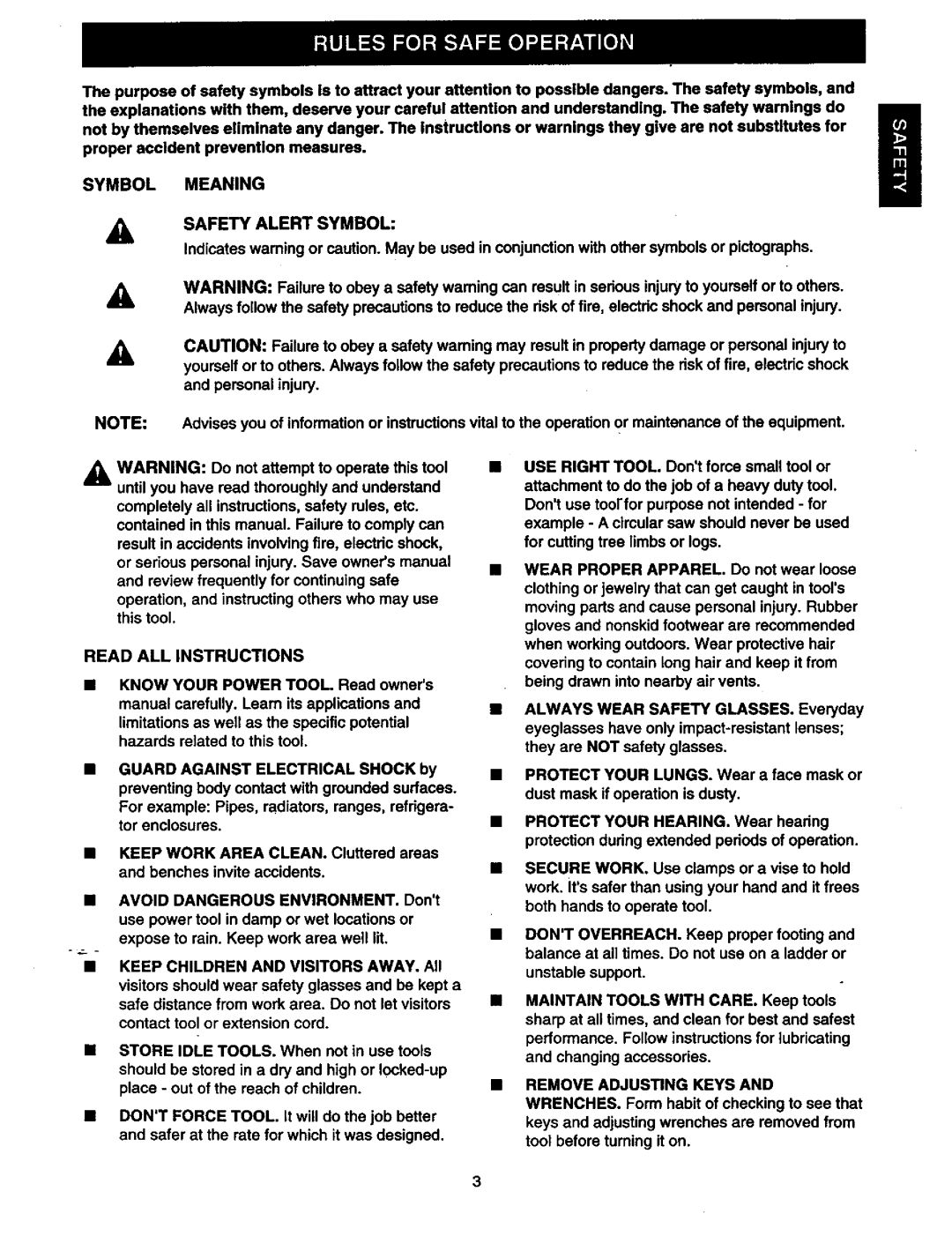
Thepurposeof safetysymbolsIsto attractyour attentionto possibledangers.Thesafetysymbols,end theexplanationswith them,deserveyour carefulattentionandunderstandingThesafetywarningsdo.
notbythemselveseliminateanydanger.The instrucUons or warnings they give are not substitutes for
proper accident prevention measures.
SYMBOL MEANING
A
A
SAFETY ALERTSYMBOL:
Indic_eswamingorcaution. Maybeusadin co_unctionwitho_er_mbolsorpictogmphs.
WARNING: Failure to obey a safety warning can result in serious injury to yourself or to others. Always follow the safety precautions to reduce the dsk of fire, electdc shock and personal injury.
| A | CAUTION: | Failure to obey a safety waming may result in property damage or personal injury to | ||||||
|
| ||||||||
|
| yourself or to others. Always follow the safety precautions to reduce the risk of fire, electric shock | |||||||
|
| and personal injury. |
|
|
| ||||
| NOTE: | Advises you of information or instructions vital to the operation Or maintenance of the equipment. | |||||||
,_ | WARNING: | Do not attempt to operate this tool | • | USE RIGHT TOOL. Don'tforce small tool or | |||||
attachment to do the job of a heavy duty tool. | |||||||||
| until you have read thoroughly and understand |
| |||||||
| completely all instructions, safety rules, etc. |
| Don_ use tool'forpurpose not intended - for | ||||||
| contained in this manual. Failure to comply can |
| example - A cimular saw should never be used | ||||||
| result in accidents involving fire, electdc shock, |
| for cutting tree limbs or logs. | ||||||
| or serious personal injury. Save owner'smanual | • | WEAR PROPER APPAREL. Do not wear loose | ||||||
| and review frequently for continuing safe |
| clothing or jewelry that can get caught in tool's | ||||||
| operation, and instructing others who may use |
| |||||||
|
| moving parts and cause personal injury. Rubber | |||||||
| this tool. |
|
|
|
| ||||
|
|
|
|
| gloves and nonskid footwear are recommended | ||||
|
|
|
|
|
|
| |||
READ ALL | INSTRUCTIONS |
| when working outdoors. Wear protective hair | ||||||
| covedng to contain long hair and keep it from | ||||||||
|
|
|
|
|
|
| |||
| KNOW YOUR | POWER | TOOL. Read owner's |
| being drawn into nearby air vents. | ||||
| manual carefully. Learn its applications and |
| ALWAYS WEAR SAFETY GLASSES. Everyday | ||||||
| limitations as well as the specific potential |
| |||||||
|
| eyeglasses have only | |||||||
| hazards related to this tool. |
| |||||||
|
| they are NOT safety glasses. | |||||||
|
|
|
|
|
|
| |||
| GUARD AGAINST | ELECTRICAL SHOCK by |
| PROTECT YOUR LUNGS. Wear a face mask or | |||||
| preventing body contact with grounded surfaces. |
| dust mask if operation is dusty. | ||||||
| For example: Pipes, radiators, ranges, refdgera- |
| |||||||
|
| PROTECT YOUR HEARING. Wear headng | |||||||
| tor enclosures. |
|
|
| |||||
• | KEEP WORK AREA CLEAN. Cluttered areas |
| protection dudng extended pededs of operation. | ||||||
|
|
| |||||||
| and benches invite accidents. |
| SECURE WORK. Use clamps or a vise to hold | ||||||
| AVOID | DANGEROUS | ENVIRONMENT. Don't |
| work. It'ssafer than using your hand and it frees | ||||
|
| both hands to operate tool. | |||||||
| use power tool in damp or wet locations or |
| |||||||
|
| DON'T OVERREACH. | Keep proper footing and | ||||||
| expose to rain. Keep work area well lit, |
| |||||||
| KEEP CHILDREN AND VISITORS AWAY. All |
| balance at all times. Do not use on a ladder or | ||||||
|
| unstable support. |
| ||||||
| visitors should wear safety glasses and be kept a |
|
| ||||||
|
| MAINTAIN TOOLS WITH CARE. Keep tools | |||||||
| safe distance from work area. Do not let visitors |
| |||||||
| contact tool or extension cord. |
| sharp at all times, and clean for best and safest | ||||||
• | STORE | IDLE TOOLS. When not in use tools |
| performance. Follow instructions for lubricating | |||||
| and changing accessories. | ||||||||
| should be stored in a dry and high or |
| |||||||
|
| REMOVE ADJUSTING | KEYS AND | ||||||
| place - out of the reach of children. |
| |||||||
|
| WRENCHES. Form habit of checking to see that | |||||||
• | DON'TFORCE TOOL. It will do the job better |
| |||||||
| keys and adjusting wrenches are removed from | ||||||||
|
|
|
|
|
|
| |||
and safer at the rate for which it was designed. | tool before turning it on. |
|
3
